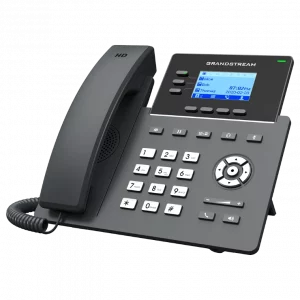
SIP Server Defined
What Is a SIP Server?
A SIP server is an alternative to the traditional telecommunications protocols commonly used in connecting businesses. You can implement this scalable solution at a fraction of the cost of traditional Public Switched Telephone Network (PSTN).
Using SIP infrastructure, you can consolidate your resources and communicate with clear, high-quality voice and other data. The acronym SIP stands for Session Initiation Protocol. It is a signaling protocol that sets up, connects, or disconnects a communication session (such as a call) between two or more people. The IP telephony industry uses this concept widely.
The SIP protocol leverages the internet to deliver communications sessions during a call. As a result, it is a more reliable method of connecting. With SIP, your company can send voice or video communication over SIP channels or trunks.
Other characteristics of the SIP server are:
- This protocol operates at the application layer and supports communication processes.
- The multimedia items initiate or finish using SIP.
- Multiple participants can join a session.
- Participants can both receive and transmit information using this communications model.
People often make the mistake of believing that SIP trunking provides all communication services for them, but it doesn’t happen this way. As we mentioned above, SIP only performs two primary functions:
- Sets up calls, conferences and any other similar form of communication
- Terminates the call once the session is complete
Additionally, SIP functions include the following five criteria:
- The user’s location. According to this criterion, the protocol knows where the end system for the call is.
- The availability of users. The protocol determines whether the called party is available to accept the call or not.
- The user’s capabilities. During the call, this criterion determines which media format will be used.
- The session’s configuration. One user rings the other while the other picks up.
- The session’s management. This process is responsible for carrying out communication sessions, such as transferring a call and terminating it.
Related: How SIP Trunking Reduces Communications Costs
Why Do Businesses Use SIP?
The use of SIP servers allows companies to improve the voice capabilities they already have with their legacy phones. SIP provides various tools and services such as video conferencing, chat, instant messaging, business analytics, desktop sharing, whiteboards and more.
A recent report by Research and Markets reveals how SIP technologies are becoming increasingly popular worldwide:
- In 2019, the market value for SIP trunking was USD 13.44 billion.
- In 2027, the SIP trunking market value could reach as much as $30.22 billion.
- Between 2020 and 2027, this technology may grow at a 10.8% annual rate.
SIP servers help improve telecommunications infrastructure in companies. This simple design, light maintenance and cost-effective solution provide organizations with a better foundation that requires fewer resources to manage, deploy and expand.
Communication is vital for any business, so if you haven’t done your research yet, you might want to consider the following advantages of installing SIP trunks in your company.
- Increased availability: Your organization will always be accessible to your customers and other external parties with this technology. It is essential for your business to offer excellent customer service and to communicate effectively. In fact, 92% of consumers are more likely to discontinue purchases from a company after three or fewer unsatisfactory customer service experiences, according to a recent study.
- More reliability: SIP protocols don’t have the same drawbacks as traditional phone lines, like bad weather interruptions (which, sometimes, are hard to fix) or power outages. In case of loss of service or connection, SIP trunks use the internet and have backup systems to guarantee that you remain online for as much time as possible.
- Fewer costs: A SIP server eliminates the need for PRI lines and the associated costs. In a PRI line, there are 23 channels, but in a SIP trunk, there can be as few as one channel (corresponding to one concurrent call). Small and large businesses can easily buy and pay for only what they need as their capacity requirements change. As an alternative, you can use an analog adapter or a “SIP-to-T1 gateway” if your company wants to maintain its existing PBX equipment to save more money on telecom costs.
- More features: SIP calls allow users to make both national calls (within the U.S.) and international calls (to Canada and Europe, for instance). Providers offering premium services will offer call forwarding, email, voicemail and caller ID at no extra charge.
In short, companies that implement SIP servers will see substantial returns on their investments after implementing this system. Configuration is more straightforward, requires less maintenance and upgrades are also affordable. It will be possible for businesses to implement VoIP telephony without using a firewall or IP-PSTN gateway. A simple layout and design and intelligent resource utilization will make this a cost-efficient solution for these enterprises with better bandwidth use, easier network maintenance and fewer hardware requirements.
Related: Everything You Need to Know About SIP Protocol
What Does the Best SIP Provider Offer
SIP trunking enables companies to connect their data networks with their existing phone networks. You can connect your company’s internet service provider directly to your SIP trunk, and you can use IP telephony without any restrictions from a company’s firewall.
As stated above, SIP trunks are pathways that transport digital data packets (voice, video, data) through the network, from the Private Branch Exchange (PBX) to their endpoint. Each trunk can be divided into as many SIP channels (also known as sessions, lines, or concurrent calls) as needed to support inbound or outbound calls.
This whole process may seem complicated, but the best SIP provider can make it easy for you. Here is a list of the main advantages of the most reliable SIP trunk providers, in case you’re considering a SIP server for your business or just want to learn more:
- Guaranteed faster ROI: Compared with traditional PSTN networks, a SIP trunk installation from the best supplier requires less initial investment and generates cost savings over time.
- Agile implementation: You will receive detailed deployment instructions and professional assistance with technical issues when needed.
- Full Scalability: You can easily add new channels and trunks as your business grows, often within a few hours.
- Portability: You can continue using the old phone numbers (local or toll-free) with the new SIP service.
- Simple maintenance: A user-friendly online control panel will allow you to keep an eye on, maintain and support your data network.
- Assured Redundancy: Due to the ability to use multiple service providers, SIP trunks from a top supplier offer your company protection from power outages and downtime.
- Internet Provider Adaptability: Some SIP suppliers won’t let you pick your internet service provider. However, SIP trunks from reputable companies work with your preferred ISP.
- Platform Compatibility: The best companies should have access to all major IP PBX, IP gateways and open-source PBX solutions.
- Free Trial: Businesses that are confident in their capabilities will let you experience the main features and the best of their technology for free.
Now that you have a better understanding of SIP servers and how they work, it may be an ideal time to give them a try to help improve your business communications. With SIP.us, you can experience SIP trunks free of charge and easily install them in your company. Get started now.


